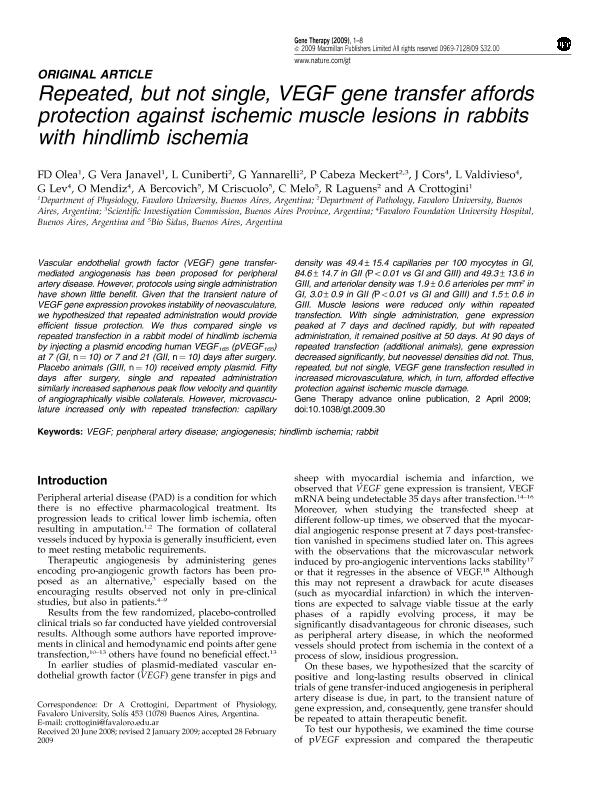Artículo
Repeated, but not single, VEGF gene transfer affords protection against ischemic muscle lesions in rabbits with hindlimb ischemia
Olea, Fernanda Daniela ; Vera Janavel, G.; Cuniberti, Luis Alberto
; Vera Janavel, G.; Cuniberti, Luis Alberto ; Yannarelli, Gustavo Gabriel
; Yannarelli, Gustavo Gabriel ; Cabeza Meckert, Patricia; Cors, J.; Valdivieso, L.; Lev, G.; Mendiz, O.; Bercovich, A.; Criscuolo, M.; Melo, C.; Laguens, R.; Crottogini, Alberto José
; Cabeza Meckert, Patricia; Cors, J.; Valdivieso, L.; Lev, G.; Mendiz, O.; Bercovich, A.; Criscuolo, M.; Melo, C.; Laguens, R.; Crottogini, Alberto José
 ; Vera Janavel, G.; Cuniberti, Luis Alberto
; Vera Janavel, G.; Cuniberti, Luis Alberto ; Yannarelli, Gustavo Gabriel
; Yannarelli, Gustavo Gabriel ; Cabeza Meckert, Patricia; Cors, J.; Valdivieso, L.; Lev, G.; Mendiz, O.; Bercovich, A.; Criscuolo, M.; Melo, C.; Laguens, R.; Crottogini, Alberto José
; Cabeza Meckert, Patricia; Cors, J.; Valdivieso, L.; Lev, G.; Mendiz, O.; Bercovich, A.; Criscuolo, M.; Melo, C.; Laguens, R.; Crottogini, Alberto José
Fecha de publicación:
06/2009
Editorial:
Nature Publishing Group
Revista:
Gene Therapy
ISSN:
0969-7128
Idioma:
Inglés
Tipo de recurso:
Artículo publicado
Clasificación temática:
Resumen
Vascular endothelial growth factor (VEGF) gene transfer-mediated angiogenesis has been proposed for peripheral artery disease. However, protocols using single administration have shown little benefit. Given that the transient nature of VEGF gene expression provokes instability of neovasculature, we hypothesized that repeated administration would provide efficient tissue protection. We thus compared single vs repeated transfection in a rabbit model of hindlimb ischemia by injecting a plasmid encoding human VEGF165 (pVEGF165) at 7 (GI, n=10) or 7 and 21 (GII, n=10) days after surgery. Placebo animals (GIII, n=10) received empty plasmid. Fifty days after surgery, single and repeated administration similarly increased saphenous peak flow velocity and quantity of angiographically visible collaterals. However, microvasculature increased only with repeated transfection: capillary density was 49.4±15.4 capillaries per 100 myocytes in GI, 84.6±14.7 in GII (P<0.01 vs GI and GIII) and 49.3±13.6 in GIII, and arteriolar density was 1.9±0.6 arterioles per mm2 in GI, 3.0±0.9 in GII (P<0.01 vs GI and GIII) and 1.5±0.6 in GIII. Muscle lesions were reduced only within repeated transfection. With single administration, gene expression peaked at 7 days and declined rapidly, but with repeated administration, it remained positive at 50 days. At 90 days of repeated transfection (additional animals), gene expression decreased significantly, but neovessel densities did not. Thus, repeated, but not single, VEGF gene transfection resulted in increased microvasculature, which, in turn, afforded effective protection against ischemic muscle damage.
Palabras clave:
VEGF
,
PERIPHERAL ARTERY DISEASE
,
ANGIOGENESIS
,
HINDLIMB ISCHEMIA
Archivos asociados
Licencia
Identificadores
Colecciones
Articulos(SEDE CENTRAL)
Articulos de SEDE CENTRAL
Articulos de SEDE CENTRAL
Citación
Olea, Fernanda Daniela; Vera Janavel, G.; Cuniberti, Luis Alberto; Yannarelli, Gustavo Gabriel; Cabeza Meckert, Patricia; et al.; Repeated, but not single, VEGF gene transfer affords protection against ischemic muscle lesions in rabbits with hindlimb ischemia; Nature Publishing Group; Gene Therapy; 16; 6; 6-2009; 716-723
Compartir
Altmétricas



